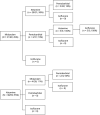Ketamine for Management of Neonatal and Pediatric Refractory Status Epilepticus
- PMID: 35817569
- PMCID: PMC10499431
- DOI: 10.1212/WNL.0000000000200889
Ketamine for Management of Neonatal and Pediatric Refractory Status Epilepticus
Abstract
Background and objectives: Few data are available regarding the use of anesthetic infusions for refractory status epilepticus (RSE) in children and neonates, and ketamine use is increasing despite limited data. We aimed to describe the impact of ketamine for RSE in children and neonates.
Methods: Retrospective single-center cohort study of consecutive patients admitted to the intensive care units of a quaternary care children's hospital treated with ketamine infusion for RSE.
Results: Sixty-nine patients were treated with a ketamine infusion for RSE. The median age at onset of RSE was 0.7 years (interquartile range 0.15-7.2), and the cohort included 13 (19%) neonates. Three patients (4%) had adverse events requiring intervention during or within 12 hours of ketamine administration, including hypertension in 2 patients and delirium in 1 patient. Ketamine infusion was followed by seizure termination in 32 patients (46%), seizure reduction in 19 patients (28%), and no change in 18 patients (26%).
Discussion: Ketamine administration was associated with few adverse events, and seizures often terminated or improved after ketamine administration. Further data are needed comparing first-line and subsequent anesthetic medications for treatment of pediatric and neonatal RSE.
Classification of evidence: This study provides Class IV evidence on the therapeutic utility of ketamine for treatment of RSE in children and neonates.
© 2022 American Academy of Neurology.
Conflict of interest statement
N. Abend was supported by the Wolfson Family Foundation. I. Helbig was supported by The Hartwell Foundation through an Individual Biomedical Research Award and by the NORSE Foundation. The other authors report no relevant disclosures. Go to
References
-
- Hirsch LJ, Gaspard N, van Baalen A, et al. . Proposed consensus definitions for new-onset refractory status epilepticus (NORSE), febrile infection-related epilepsy syndrome (FIRES), and related conditions. Epilepsia. 2018;59(4):739-744. - PubMed
-
- Keros S, Buraniqi E, Alex B, et al. . Increasing ketamine use for refractory status epilepticus in US pediatric hospitals. J Child Neurol. 2017;32(7):638-646. - PubMed
-
- Prisco L, Ganau M, Aurangzeb S, et al. . A pragmatic approach to intravenous anaesthetics and electroencephalographic endpoints for the treatment of refractory and super-refractory status epilepticus in critical care. Seizure. 2020;75:153-164. - PubMed
-
- Wilkes R, Tasker RC. Intensive care treatment of uncontrolled status epilepticus in children: systematic literature search of midazolam and anesthetic therapies. Pediatr Crit Care Med. 2014;15(7):632-639. - PubMed
Publication types
MeSH terms
Substances
Grants and funding
LinkOut - more resources
Full Text Sources
Research Materials

